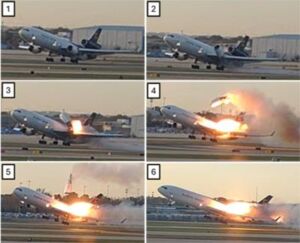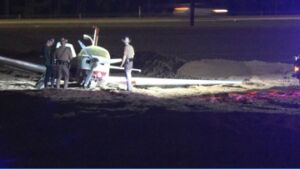We close out this week with the following stories...
Have a safe weekend!
Tom
-
NTSB Releases Preliminary Report On UPS Flight 2976
New Photos Show Engine/Pylon Separation, ‘Evidence Of Fatigue Cracks’
The National Transportation Safety Board released its Preliminary Report on the crash of UPS Flight 2976 on November 4, 2025, as it took off from Louisville Muhammad Ali International Airport (SDF) in Kentucky. The 3 crew members on board and 11 people on the ground were fatally injured, and 23 additional people on the ground were injured.
its Preliminary Report on the crash of UPS Flight 2976 on November 4, 2025, as it took off from Louisville Muhammad Ali International Airport (SDF) in Kentucky. The 3 crew members on board and 11 people on the ground were fatally injured, and 23 additional people on the ground were injured.
Following the accident, the NTSB traveled to the airport on November 5, started to document the accident site, and collected any perishable data related to the investigation.
Newly-released airport surveillance video shows the separation of the left engine and pylon from the left wing, igniting a fire that engulfed the left wing and caused the aircraft to roll to the left and impact buildings and the ground about a half mile beyond the runway end.
In the frame-by-frame photos from the surveillance video, the left engine can be seen rotating upward from the wing, and as it detaches from the wing, a fire ignites that engulfs both the departing engine/pylon and the area of the wing where the engine was attached.
The report says that the fire ignited near the left pylon attachment area. In its technical findings, the report The board said there was “evidence of fatigue cracks” and “areas of overstress failure” in the left pylon aft mount lug fractures and the “Spherical bearing outer race had fractured circumferentially.
The last detailed visual inspection of the left pylon aft mount was performed on October 28, 2021, and wasn’t due for another for about 7,000 more flights.
aft mount was performed on October 28, 2021, and wasn’t due for another for about 7,000 more flights.
The investigation is continuing with the involvement of the FAA, UPS, Boeing, Independent Pilots Association, and GE Aerospace. It is focusing on structures, systems, powerplants, and human performance.
FMI: www.ntsb.gov/
Private jet makes emergency landing in North Alabama due to reported fire
Lynne Keenum - Producer
MUSCLE SHOALS, Ala. —
A private aircraft made an emergency landing at Muscle Shoals Airport on Thursday after a reported fire, according to WAFF.
Muscle Shoals Airport on Thursday after a reported fire, according to WAFF.
Emergency crews rushed to the airport after the pilot of the Learjet reported a possible fire on board.
According to the Times Daily newspaper, the aircraft was on its way from Nashville to Dallas when it was forced to make an immediate landing.
The Muscle Shoals Fire Department was on the runway as a precaution before the jet was to land. No injuries were reported.
https://www.wvtm13.com/article/alabama-airplane-emergency-landing-muscle-shoals/69498620
Pilot lands aircraft in new housing development after engine trouble, HCSO says
A 42-year-old pilot walked away without injuries after landing a 1967 Mooney M20E in a field near the Grand Parkway following reported engine trouble, deputies say.
Author: Jaime E. Galvan
HARRIS COUNTY, Texas — A pilot is alive Friday morning after making an emergency landing overnight near the Grand Parkway in west Harris County, according to the Harris County Sheriff’s Office.
morning after making an emergency landing overnight near the Grand Parkway in west Harris County, according to the Harris County Sheriff’s Office.
Deputies say the 42-year-old man was flying a 1967 Mooney M20E when he reported engine trouble in the air. Moments later, investigators say he landed the plane in a field inside a new housing development.
Pilot walks away from crash
Despite the hard landing, the sheriff’s office says the pilot walked away without injuries.
The aircraft, however, was damaged during the landing, deputies say.
Investigation underway
The Federal Aviation Administration will help determine what happens next, as the Texas Department of Public Safety continues its investigation into the landing.
This is a developing story. More updates are expected as investigators release additional information.
https://www.khou.com/article/news/local/grand-parkway-plane-crash-emergency-landing-west-harris-county/285-2d1a4437-d8e4-43c6-aebd-52544e843795
NTSB Prelim: Funk B85C
According To The Witness, Once The Airplane Landed, It Continued To Roll In A Relatively Straight Line Until It Impacted A Tree In His Front Yard
Location: Anderson, IN Accident Number: CEN26FA034
Date & Time: November 4, 2025, 12:45 Local Registration: N24157
Aircraft: Funk B85C Injuries: 1 Fatal
Flight Conducted Under: Part 91: General aviation - Personal
On November 4, 2025, about 12:45 eastern standard time, a Funk B85C airplane, N24157 was destroyed when it was involved in an accident near Anderson, Indiana. The pilot was fatally injured. The airplane was operated under the provisions of Title 14 Code of Federal Regulations Part 91 as a personal flight.
The airplane departed a private grass airfield (II26) in Wolcott, Indiana, earlier on the day of the accident and was enroute to Anderson Regional Airport (AID), Anderson, Indiana. The airplane was recently purchased, and the pilot was flying the airplane to AID for the new owner. A video was taken of the airplane departing II26 for AID. No anomalies were noted with the airplane during the takeoff or departure.
An air traffic controller at the AID tower stated that the pilot reported that he was 10 miles from AID inbound for landing. The controller told the pilot to report a 2 mile final approach for runway 12. The pilot read back the request to report a 2 mile final for runway 12. The controller did not have any further contact with the pilot. The controller stated that the pilot did not seem to be in distress during the radio communications.
A witness standing in his yard at the time of the accident said that he saw the airplane fly northbound along County Road 100 West in Anderson, Indiana. The witness reported that the airplane then turned sharply to the west and then to south before it landed in a dirt field adjacent to his property. The witness stated that he thought he heard the engine popping or backfiring during the landing sequence. According to the witness, once the airplane landed, it continued to roll in a relatively straight line until it impacted a tree in his front yard. The witness said that the engine was not running during the landing rollout, but the propeller was spinning. The witness also stated that he could see the pilot, and the pilot’s eyes were open, and both of his hands were on the yoke.
After the airplane impacted the tree, a fire ignited. The witness stated that flames were coming out of the broken windshield. The witness obtained a fire extinguisher and started to extinguish the fire. People traveling on County Road 100 West stopped their vehicles and assisted in extinguishing the fire and extracting the pilot from the airplane. When asked if there was smoke or fire coming from the airplane prior to the airplane impacting the tree, the witness said there was none.
The airplane landed on a heading of about 179°. A divot in the field consistent with the size and shape of the tailwheel, marked the area where the airplane touched down. From the initial touchdown point to the tree was a single set of tire tracks. The airplane traveled about 835 ft from where it first touched down until it impacted the tree.
The front of the airplane was crushed, and tree bark was embedded in the # 3 engine cylinder. The propeller was straight and undamaged. It did not exhibit any curling or polishing. The firewall and cabin were thermally damaged. The mixture was in the full- rich position, and the throttle was partially out. The ignition was in the “both” position. Fuel selector position prior to the accident could not be determined due to the fuel selector breaking free during the impact sequence. Fuel was dripping from the fuel line attached to the fuel selector. Postaccident, about 7 gallons of fuel was drained from the airplane’s sole fuel tank.
The elevator and ailerons moved freely when the yoke was manipulated. The rudder moved freely when the rudder pedals were depressed. The brakes on both the left and right main wheels activated when the brakes were depressed. The wings were still attached to the fuselage; however, the ribs and spars on the inboard side of both wings were cracked. The cloth fabric on the wings was rippled and wrinkled.
The #1 and #3 engine cylinders had damaged fins consistent with damage received during the impact sequence, and the #3 cylinder was displaced aft. The engine case was cracked near the #1 and #3 cylinders consistent with impact damage. The interior of all 4 cylinders was examined with a borescope, and no anomalies were noted. Thumb compressions were obtained on all 4 cylinders. All 8 spark plugs were found to be normal when tested against the Champion Aviation Check-A-Plug chart. Both the left and right magnetos fired when tested.
The oil filter screen was clear of debris and the oil dipstick read “full.” The gascolator screen was clean and free of debris, and the gascolator was full of fuel. The fuel inside the gascolator was tested for water utilizing Kolor Kut Water Finding Paste®. No water was detected. The carburetor screen was clean and free of debris, and there was fuel in the carburetor bowl.
The airplane was retained for further examination.
FMI: www.ntsb.gov

Today in History
21 Years ago today: On 21 November 2004 China Yunnan Airlines flight 5210, a Canadair CRJ-200, crashed following a loss of control after takeoff from Baotou Airport, China, killing all 53 occupants and 2 persons on the ground.
| Date: | Sunday 21 November 2004 |
| Time: | 08:20 |
| Type: | Canadair CL-600-2B19 Regional Jet CRJ-200LR |
| Owner/operator: | China Yunnan Airlines |
| Registration: | B-3072 |
| MSN: | 7697 |
| Year of manufacture: | 2002 |
| Engine model: | General Electric CF34-3B1 |
| Fatalities: | Fatalities: 53 / Occupants: 53 |
| Other fatalities: | 2 |
| Aircraft damage: | Destroyed, written off |
| Category: | Accident |
| Location: | near Baotou Airport (BAV) - China |
| Phase: | Initial climb |
| Nature: | Passenger - Scheduled |
| Departure airport: | Baotou Airport (BAV/ZBOW) |
| Destination airport: | Shanghai-Hongqiao Airport (SHA/ZSSS) |
| Confidence Rating: | Information is only available from news, social media or unofficial sources |
Narrative:
China Yunnan Airlines flight 5210, a Canadair CRJ-200, crashed following a loss of control after takeoff from Baotou Airport, China, killing all 53 occupants and 2 persons on the ground.
Regional Jet B-3072 was parked overnight at the Baotou Airport in cold weather conditions. Prior to departure on the morning service to Shanghai (SHA), flight MU5210 was not de-iced. The wings were contaminated by the overnight frost, which severely degraded the aerodynamic characteristics of the wing. Shortly after the airplane rotated, it entered a stall. The pilots were not able to regain control. The CRJ200 crashed into a frozen lake in Nanhai Park just two kilometers past the runway. The aircraft struck a park ticket office, killing two park employees, before it crashed into the water.
